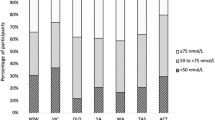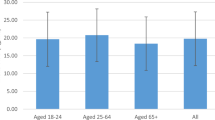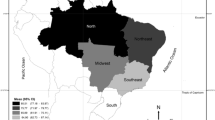Abstract
Objective: To examine zinc and vitamin A intake and status and associated dietary, socio-demographic, lifestyle and physiological factors in British young people.
Design: National Diet and Nutrition Survey of young people aged 4–18 y.
Setting: Great Britain, 1997.
Subjects: Complete 7-day weighed dietary records were provided by 1520 participants, while 1193 provided blood samples.
Results: A total of 13 and 11% of participants respectively reported low dietary intakes of zinc and vitamin A (retinol equivalents), relative to the UK lower reference nutrient intake. These percentages were not altered significantly by including contributions to intake from supplements, mainly containing vitamin A (as retinol). Likelihood of low zinc and/or vitamin A intake was more often associated with age, sex and likely under-reporting of food consumption than with other socio-demographic and lifestyle factors. Low zinc and vitamin A intakes were generally less likely in those with higher consumption of dairy foods (mainly milk). Zinc and vitamin A status (assessed by plasma zinc and retinol concentrations) were adequate in almost all participants. Plasma zinc concentration was not significantly associated with zinc intake. Plasma retinol concentration was correlated with vitamin A intake (overall r=0.17, P<0.001; adjusted for age and plasma α1-antichymotrypsin concentration) and increased significantly with age (P<0.001) in both sexes. A significant association was found between plasma zinc and retinol concentrations in boys only (r=0.17, P=0.001).
Conclusions: Zinc and vitamin A intakes and status were generally adequate in this national sample of British young people.
Sponsorship: Food Standards Agency, UK.
This is a preview of subscription content, access via your institution
Access options
Subscribe to this journal
Receive 12 print issues and online access
$259.00 per year
only $21.58 per issue
Buy this article
- Purchase on Springer Link
- Instant access to full article PDF
Prices may be subject to local taxes which are calculated during checkout
Similar content being viewed by others
References
Ahmed F, Khan MR, Faruque MO, Taj S, Hyderi T & Jackson AA (1998): Serum retinol is influenced by social factors and antioxidant nutrients among adolescent girls in urban Bangladesh. Int. J. Food Sci. Nutr. 49, 39–44.
Ahn J & Koo SI (1995): Effects of zinc and essential fatty acid deficiencies on the lymphatic absorption of vitamin A and secretion of phospholipids. J. Nutr. Biochem. 6, 595–603.
Ballew C, Bowman BA, Sowell AL & Gillespie C (2001): Serum retinol distributions of the United States: third National Health and Nutrition Examination Survey, 1988–1994 . Am. J. Clin. Nutr. 73, 586–593.
Briefel RR, Bialostosky K, Kennedy-Stephenson J, McDowell MA, Ervin RB & Wright JD (2000): Zinc intake of the U.S. population: findings from the third National Health and Nutrition Examination Survey, 1988–1994. J. Nutr. 130, S1367–S1373.
Butrimovitz GP & Purdy WC (1978): Zinc nutrition and growth in a childhood population. Am. J. Clin. Nutr. 31, 1409–1412.
Calvin J & Price CP (1986): Measurement of serum α1-anti-chymotrypsin by immunoturbidimetry. Ann. Clin. Biochem. 23, 206–209.
Crawley H & Shergill-Bonner R (1995): The nutrient and food intakes of 16–17 year old female dieters in the UK. J. Hum. Nutr. Diet. 8, 25–34.
Crawley HF & Summerbell CD (1998): The nutrient and food intakes of British male dieters aged 16–17 years. J. Hum. Nutr. Diet. 11, 33–40.
Department of Health (1989): The Diets of British Schoolchildren. Report on Health and Social Subjects No. 36. London: HMSO.
Department of Health (1991): Dietary Reference Values for Food Energy and Nutrients for the United Kingdom. Report on Health and Social Subjects No. 41. London: HMSO.
Goode HF, Kelleher J & Walker BE (1991): The effects of acute infection on indices of zinc status. Clin. Nutr. 10, 55–59.
Great Britain Office of Population Censuses and Surveys (1991): Standard Occupational Classifications, Vol 3, Social Classifications and Coding Methodology. London: HMSO.
Gregory JR, Collins DL, Davies PSW, Hughes JM & Clarke PC (1995): National Diet and Nutrition Survey: Children Aged 1.5 to 4.5 Years. Vol 1. Report of the Diet and Nutrition Survey. London: HMSO.
Gregory J, Lowe S, Bates CJ, Prentice A, Jackson LV, Smithers G, Wenlock R & Farron M (2000): National Diet and Nutrition Survey: Young People Aged 4 to 18 Years. Vol 1: Report of the Diet and Nutrition Survey. London: The Stationery Office.
Herbeth B, Spyckerelle Y & Deschamps J-P (1991): Determinants of plasma retinol, β-carotene, and α-tocopherol during adolescence. Am. J. Clin. Nutr. 54, 884–889.
Hurson M & Corish C (1997): Evaluation of lifestyle, food consumption and nutrient intake patterns among Irish teenagers. Ir. J. Med. Sci. 166, 225–230.
Institute of Medicine (2001): Dietary Reference Intakes for Vitamin A, Vitamin K, Arsenic, Boron, Chromium, Copper, Iodine, Iron, Manganese, Molybdenum, Nickel, Silicon, Vanadium, and Zinc. Washington, DC: National Academy Press.
Lewis CJ, McDowell MA, Sempos CT, Lewis KC & Yetley EA (1990): Relationship between age and serum vitamin A in children aged 4–11 y. Am. J. Clin. Nutr. 52, 353–360.
Lockitch G, Halstead AC, Wadsworth L, Quigley G, Reston L & Jacobson B (1988): Age- and sex-specific pediatric reference intervals and correlations for zinc, copper, selenium, iron, vitamins A and E, and related proteins. Clin. Chem. 34, 1625–1628.
Löwik MRH, Hulshof KFAM, van der Heijden LJM, Brussaard JH, Burema J, Kistemaker C & de Vries PJF (1998): Changes in the diet in The Netherlands: 1987–88 to 1992. Int. J. Food Sci. Nutr. 4, S1–S64.
Malvy DJ-M, Arnaud J, Burtschy B, Richard M-J, Favier A, Houot O & Amédée-Manesme O (1993): Reference values for serum zinc and selenium of French healthy children. Eur. J. Epidemiol. 9, 155–161.
Michaëlsson G, Vahlquist A, Juhlin L, Mellbin T & Bratt L (1976): Zinc and vitamin A: serum concentrations of zinc and retinol-binding protein (RBP) in healthy adolescents. Scand. J. Clin. Invest. 36, 827–832.
Ministry of Agriculture, Fisheries and Food (1993): Food Portion Sizes, 2nd Edition. London: HMSO.
Neuhoser ML, Rock CL, Eldridge AL, Kristal AR, Patterson RE, Cooper DA, Neumark-Sztainer D, Cheskin LJ & Thornquist MD (2001): Serum concentrations of retinol, α-tocopherol and the carotenoids are influenced by diet, race and obesity in a sample of healthy adolescents. J. Nutr. 131, 2184–2191.
Paracha PI, Jamil A, Northrop-Clewes CA & Thurnham DI (2000): Interpretation of vitamin A status in apparently healthy Pakistani children by using markers of subclinical infection. Am. J. Clin. Nutr. 72, 1164–1169.
Pilch SM (ed.) (1985): Assessment of the Vitamin A Nutritional Status of the US Population Based on Data Collected in the Health and Nutrition Examination Surveys. Bethesda, MD: Federation of American Societies for Experimental Biology.
Pilch SM & Senti FR (eds.) (1984): Assessment of Zinc Nutritional Status of the US Population Based on Data Collected in the 2nd National Health and Examination Survey 1976–80. Bethesda, MD: Federation of American Societies for Experimental Biology.
Pilch SM & Senti FR (1985): Analysis of zinc data from the second National Health and Nutrition Examination Survey (NHANES II). J. Nutr. 115, 1393–1397.
Rahman MM, Wahed MA, Fuchs GJ, Baqui AH & Alvarez JO (2002): Synergistic effect of zinc and vitamin A on the biochemical indexes of vitamin A nutrition in children . Am. J. Clin. Nutr. 75, 92–98.
Rükgauer M, Klein J & Kruse-Jarres JD (1997): Reference values for the trace elements copper, manganese, selenium, and zinc in the serum/plasma of children, adolescents, and adults. J. Trace Elem. Med. Biol. 11, 92–98.
Samuelson G, Bratteby L-E, Enghardt H & Hedgren M (1996): Food habits and energy and nutrient intake in Swedish adolescents approaching the year 2000. Acta Paediatr. Scand. 415, 1–20.
Schofield WN, Schofield C & James WPT (1985): Basal metabolic rate. Hum. Nutr. Clin. Nutr. 39C (Suppl 1), 1–96.
Shils ME, Olson JA, Shike M & Ross AC (eds) (1999): Modern Nutrition in Health and Disease, 9th Edition. Baltimore: Williams & Wilkins.
Thane CW, Bates CJ & Prentice A (2002): Oral contraceptives and nutritional status in adolescent British girls. Nutr. Res. 22, 449–462.
Thompson P, Roseborough R, Russek E, Jacobson M & Moser PB (1986): Zinc status and sexual development in adolescent girls. J. Am. Diet. Assoc. 86, 892–897.
Thurnham DI, Smith E & Flora PS (1988): Concurrent liquid chromatographic assay of retinol, α-tocopherol, β-carotene, α-carotene, lycopene and β-cryptoxanthin in plasma, with tocopherol acetate as internal standard. Clin. Chem. 34, 377–381.
Torun B, Davies PSW, Livingstone MBE, Paolisso M, Sackett R & Spurr GB (1996): Energy requirements and dietary energy recommendations for children and adolescents 1 to 18 years old. Eur. J. Clin. Nutr. 50 (Suppl 1), S37–S81.
Wagner PA, Bailey LB, Christakis GJ & Dinning JS (1985): Serum zinc concentrations in adolescents as related to sexual maturation. Hum. Nutr. Clin. Nutr. 39C, 459–462.
Wolf G, Kiorpes TC, Masushige S, Schreiber JB, Smith MJ & Anderson RS (1979): Recent evidence for the participation of vitamin A in glycoprotein synthesis. Fed. Proc. 38, 2540–2543.
Acknowledgements
This further analysis was funded by the Food Standards Agency (grant number N08014). The National Diet and Nutrition Survey (NDNS) of young people aged 4–18 y was commissioned and funded jointly by the Ministry of Agriculture, Fisheries and Food and the Department of Health. Responsibility for the NDNS programme transferred to the Food Standards Agency on its establishment in April 2000. The survey was conducted by the Social Survey Division of the Office for National Statistics in conjunction with the Micronutrient Status Laboratory, formerly part of the MRC Dunn Nutrition Unit and now part of MRC Human Nutrition Research.
Author information
Authors and Affiliations
Contributions
Guarantor: CJ Bates
Contributors: CWT analysed the data and drafted the manuscript, and CJB and AP initiated the project and contributed to the preparation of the manuscript.
Corresponding author
Rights and permissions
About this article
Cite this article
Thane, C., Bates, C. & Prentice, A. Zinc and vitamin A intake and status in a national sample of British young people aged 4–18 y. Eur J Clin Nutr 58, 363–375 (2004). https://doi.org/10.1038/sj.ejcn.1601792
Received:
Revised:
Accepted:
Published:
Issue Date:
DOI: https://doi.org/10.1038/sj.ejcn.1601792
Keywords
This article is cited by
-
Reducing dietary intake of added sugars could affect the nutritional adequacy of vitamin A in adolescents: the Costa Rica case
BMC Public Health (2023)
-
Influence of income on diet quality and daily iron and zinc intake: analysis of the National Diet and Nutrition Survey of British females aged 11–14 and 15–18 years
European Journal of Nutrition (2023)
-
Zinc deficiency in the pediatric age group is common but underevaluated
World Journal of Pediatrics (2017)
-
Pilot Study of the Association of Anemia with the Levels of Zinc, Copper, Iron, Calcium, and Magnesium of Children Aged 6 Months to 3 Years in Beijing, China
Biological Trace Element Research (2015)
-
Is the zinc intake of young people in the UK adequate?
European Journal of Clinical Nutrition (2009)



